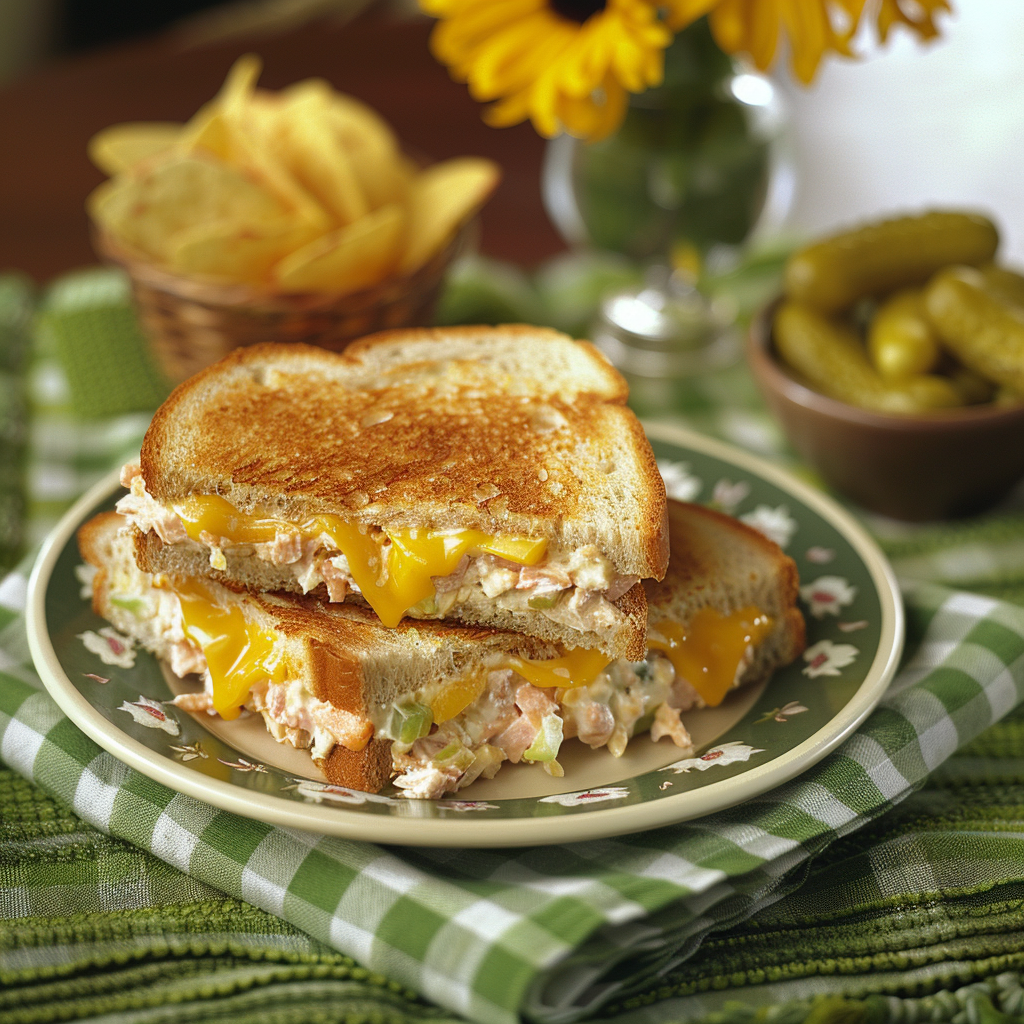Tuna Melt Sandwich Recipe – Creamy, Cheesy, and Easy to Make

Share
Tuna Melt Sandwich – An Easy Sandwich That Feels Like a Small Meal
Some sandwiches have truly stood the test of time, and the tuna melt is one of them. It takes only a few steps to transform two cold slices of bread and a can of tuna into something more exciting, warm, and satisfying. The combination of creamy tuna salad, melted cheese, and golden toasted bread elevates this simple sandwich to a whole new level. Whether you're making it for lunch or a quick dinner, the tuna melt is a classic that never disappoints.
Did You Know?
Tuna is a rich source of protein and omega-3 fatty acids, which are essential for heart health. The combination of tuna salad and melted cheese makes this sandwich a delightful mix of flavors and textures. Fun fact: The first tuna melt is said to have originated in a restaurant in Charleston, South Carolina, when a grilled cheese accidentally got some tuna salad on it!
Yield:
4 servings
Ingredients
2 cans tuna, drained
1/4 cup mayonnaise
1 tablespoon lemon juice
1/4 cup finely chopped celery
1/4 cup finely chopped red onion
1 teaspoon Dijon mustard
Salt and pepper to taste
8 slices of bread
8 slices of cheddar cheese
2 tablespoons butter, softened
Instructions
Prepare the Tuna Salad: In a large bowl, combine the tuna, mayonnaise, lemon juice, celery, red onion, Dijon mustard, salt, and pepper. Mix well.
Personal Tip: For an extra kick, add a dash of hot sauce or a pinch of paprika to the tuna salad.
Assemble the Sandwiches: Spread the tuna mixture onto 4 slices of bread. Top each with a slice of cheddar cheese, then place another slice of bread on top.
Personal Tip: Try adding thinly sliced tomatoes or avocado to the sandwich for added flavor and nutrition.
Cook the Sandwiches: Heat a skillet over medium heat and melt 1 tablespoon of butter. Place the sandwiches in the skillet and cook until the bread is golden brown and the cheese is melted, about 3-4 minutes per side. Add more butter to the skillet as needed.
Personal Tip: Press the sandwich gently with a spatula to help the cheese melt evenly.
Serve: Serve hot with a side of pickles or chips.
Personal Tip: Keep cooked sandwiches warm in a preheated oven at 200°F while you finish grilling the rest.
Nutritional Information (Per Serving):
Calories: 450, Protein: 25g, Carbohydrates: 35g, Fiber: 3g, Net Carbohydrates: 32g, Fat: 23g, Saturated Fat: 10g, Cholesterol: 60mg, Sodium: 700mg, Sugars: 5g, Glycemic Index: Medium
Kitchen Tips, Great Ideas, How to Save Money
- Using Fresh Tuna: If you prefer fresh tuna, grill or pan-sear it and then flake it into the salad mixture. Fresh tuna can offer a different flavor and texture.
- Bread Choices: Use hearty bread like sourdough or whole wheat for a more substantial sandwich. These types of bread can hold up better to the tuna mixture and provide additional nutrients.
- Cheese Variations: Feel free to experiment with different types of cheese, such as Swiss, mozzarella, or provolone, for a unique twist on the classic tuna melt.
- Adding Vegetables: Incorporate thinly sliced tomatoes or avocados in your sandwich for added flavor and nutrition. These additions complement the creamy tuna salad and melted cheese perfectly.
- Making Ahead: Prepare the tuna salad up to a day in advance and store it in the refrigerator. This can save time when you're ready to assemble and cook the sandwiches.
- Keeping Sandwiches Warm: If making multiple sandwiches, keep the cooked sandwiches warm in a preheated oven at 200°F (93°C) while you finish cooking the rest.
- Reducing Fat: For a lighter version, use reduced-fat mayonnaise and cheese. You can also use olive oil spray instead of butter for grilling the sandwiches.
- Batch Cooking: Double the recipe and freeze the extra tuna salad in portion-sized containers for quick meal prep on busy days.
- Flavor Enhancements: Add a dash of hot sauce or a pinch of paprika to the tuna salad for an extra kick. Fresh herbs like dill or parsley can also add a burst of flavor.
- Cost-Saving Tips: Buy tuna, cheese, and bread in bulk when on sale to save money. Using store-brand ingredients can also reduce costs without compromising quality.
Let’s Learn About Tuna
Tuna is a versatile and nutritious seafood option, but not all canned tuna is the same. There are several varieties, and it's important to know what to look for on the label when choosing which one to buy.
-
Albacore Tuna (White Tuna): This variety has a firm texture and mild flavor. It’s typically more expensive than other types of tuna and contains more mercury, so it's best eaten in moderation.
-
Skipjack Tuna (Light Tuna): This is the most common type of canned tuna. It has a slightly stronger flavor than albacore and is often found in "chunk light" tuna cans. It’s lower in mercury, making it a safer option for more frequent consumption.
-
Yellowfin Tuna: Known for its mild flavor and firm texture, yellowfin tuna is often more expensive but lower in mercury than albacore.
When shopping for canned tuna, consider the following:
- Packed in Water vs. Oil: Tuna packed in water is lower in calories and fat than tuna packed in oil. If you prefer tuna packed in oil for its richness, drain it well to reduce the fat content.
- Sustainability Labels: Look for certifications like MSC (Marine Stewardship Council) to ensure that your tuna is sourced sustainably.
- BPA-Free Cans: Many brands now offer BPA-free cans, which reduce exposure to harmful chemicals found in some packaging.
Tuna is a great source of protein and omega-3 fatty acids, which are beneficial for heart and brain health. By reading labels carefully, you can make informed choices about the type of tuna that fits your dietary needs and preferences.


